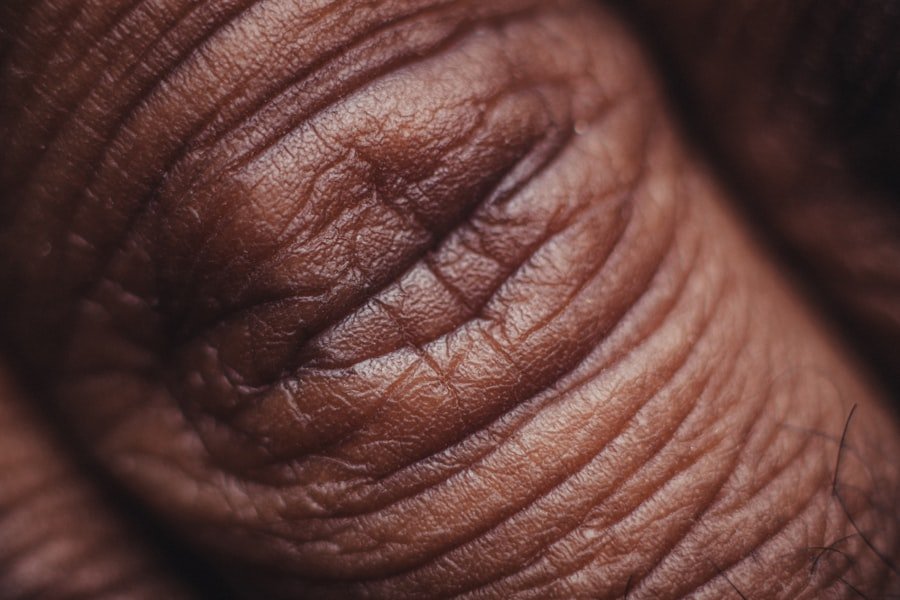Peeling fingertips can be a perplexing and often uncomfortable condition that many of us may experience at some point in our lives. This seemingly innocuous issue can range from mild irritation to a more serious concern, depending on its underlying cause. As we delve into the topic, we will explore the various reasons behind peeling fingertips, the conditions that may contribute to this phenomenon, and the treatment options available to alleviate the symptoms.
Understanding the intricacies of this condition can empower us to take proactive steps toward maintaining healthy skin on our hands. In our daily lives, we often overlook the importance of skin health, particularly on our fingertips, which are constantly exposed to various environmental factors. The skin on our hands is not only a protective barrier but also plays a crucial role in our sensory perception.
When we notice peeling skin, it can be a signal from our body that something is amiss. By examining the common causes and potential treatments for peeling fingertips, we can better equip ourselves to address this issue and promote overall skin health.
Key Takeaways
- Peeling fingertips can be caused by various factors such as eczema, contact dermatitis, psoriasis, and fungal infections.
- Eczema can cause peeling fingertips due to inflammation and irritation of the skin, leading to dryness and flaking.
- Contact dermatitis, caused by exposure to irritants or allergens, can result in peeling, redness, and itching of the fingertips.
- Psoriasis can lead to peeling fingertips as a result of the rapid turnover of skin cells, leading to thick, red, and scaly patches.
- Fungal infections, such as athlete’s foot, can cause peeling, cracking, and itching of the skin on the fingertips.
Common Causes of Peeling Fingertips
Exposure to Water and Harsh Chemicals
One of the primary reasons for peeling fingertips is frequent exposure to water or chemicals. Excessive handwashing, especially with antibacterial soaps or detergents, can strip the skin of its natural oils, leading to dryness and peeling. Prolonged exposure to water, such as during dishwashing or swimming, can further exacerbate this condition.
Environmental Factors
Environmental factors, such as cold weather or low humidity, can also contribute to peeling fingertips.
During winter months, the air tends to be drier, leading to moisture loss in our skin. This dryness can manifest as peeling or cracking, particularly around the fingertips where the skin is thinner and more delicate.
Medical Conditions and Skin Disorders
Certain medical conditions and skin disorders can also play a significant role in the development of peeling skin. By recognizing these various causes, we can take steps to mitigate their effects and maintain healthier skin.
Eczema and Peeling Fingertips

Eczema, also known as atopic dermatitis, is a chronic inflammatory skin condition that can significantly impact our quality of life. It often presents as red, itchy patches on the skin, and in some cases, it can lead to peeling fingertips. For those of us who suffer from eczema, the skin barrier is compromised, making it more susceptible to irritants and allergens.
This vulnerability can result in inflammation and peeling, particularly in areas that are frequently exposed to irritants. Managing eczema requires a multifaceted approach that includes identifying triggers and implementing appropriate skincare routines. We may find that using gentle cleansers and moisturizers specifically formulated for sensitive skin can help alleviate symptoms.
Additionally, avoiding known irritants such as certain fabrics or harsh soaps can reduce flare-ups and promote healing. By understanding the relationship between eczema and peeling fingertips, we can take proactive measures to manage our symptoms effectively.
Contact Dermatitis and Peeling Fingertips
Contact dermatitis is another condition that can lead to peeling fingertips. This occurs when our skin comes into direct contact with an irritant or allergen, resulting in an inflammatory response. Common culprits include household cleaning products, certain metals like nickel, and even some personal care items such as lotions or soaps.
For those of us who are particularly sensitive, even minor exposure can trigger a reaction that leads to redness, itching, and ultimately peeling skin.
To effectively manage contact dermatitis, it is essential for us to identify the specific irritants or allergens responsible for our symptoms. Keeping a diary of our activities and products used can help pinpoint potential triggers.
Once identified, we can take steps to avoid these substances and protect our skin. In some cases, over-the-counter topical corticosteroids may be recommended to reduce inflammation and promote healing. By being vigilant about our environment and skincare choices, we can minimize the risk of developing contact dermatitis and its associated symptoms.
Psoriasis and Peeling Fingertips
Psoriasis is a chronic autoimmune condition characterized by rapid skin cell turnover, leading to thickened patches of skin that may become red and scaly. While psoriasis typically affects larger areas of the body, it can also manifest on the fingertips, resulting in peeling skin. For those of us living with psoriasis, managing flare-ups can be challenging due to the unpredictable nature of the condition.
Treatment for psoriasis often involves a combination of topical therapies, phototherapy, and systemic medications aimed at reducing inflammation and slowing down cell turnover. We may find that using emollients regularly helps keep our skin hydrated and reduces the severity of peeling. Additionally, lifestyle modifications such as stress management and maintaining a healthy diet can play a role in managing psoriasis symptoms.
By understanding how psoriasis contributes to peeling fingertips, we can take informed steps toward effective management.
Fungal Infections and Peeling Fingertips

Fungal Infections and Their Symptoms
Conditions such as tinea manuum, a fungal infection of the hand, can lead to symptoms including redness, itching, and peeling skin. These infections thrive in warm, moist environments, making them more likely to occur in individuals who frequently have wet hands or who engage in activities that promote moisture retention.
Treatment and Prevention of Fungal Infections
To address fungal infections effectively, it is crucial for us to seek treatment options. Antifungal creams or oral medications may be prescribed depending on the severity of the infection. Additionally, practicing good hygiene by keeping our hands dry and avoiding sharing personal items can help prevent the spread of fungal infections.
Proactive Hand Health
By being proactive about our hand health and recognizing the signs of fungal infections early on, we can minimize their impact on our skin.
Treatment Options for Peeling Fingertips
When it comes to treating peeling fingertips, a tailored approach based on the underlying cause is essential for effective management. For those experiencing dryness due to environmental factors or excessive handwashing, incorporating a rich moisturizer into our daily routine can make a significant difference. We should look for products containing ingredients like glycerin or hyaluronic acid that help attract moisture to the skin.
In cases where a specific condition such as eczema or psoriasis is identified as the cause of peeling fingertips, targeted treatments may be necessary. Topical corticosteroids or immunomodulators may be prescribed by healthcare professionals to reduce inflammation and promote healing. Additionally, for individuals with contact dermatitis or allergic reactions, avoiding known irritants is crucial for preventing further irritation and allowing the skin to recover.
Home Remedies for Peeling Fingertips
In addition to medical treatments, there are several home remedies we can explore to alleviate peeling fingertips naturally. One effective remedy involves creating a soothing soak using warm water mixed with oatmeal or Epsom salt. Soaking our hands for 10-15 minutes can help hydrate the skin while providing relief from itching or discomfort.
Another popular home remedy is applying natural oils such as coconut oil or olive oil directly onto the affected areas. These oils are known for their moisturizing properties and can help restore the skin’s barrier function. We may also consider using aloe vera gel for its soothing effects on irritated skin.
By incorporating these simple home remedies into our skincare routine, we can support healing while promoting overall hand health.
When to See a Doctor for Peeling Fingertips
While peeling fingertips may often be manageable with home care and over-the-counter treatments, there are instances when seeking medical attention becomes necessary. If we notice persistent peeling accompanied by severe pain, swelling, or signs of infection such as pus or fever, it is crucial to consult a healthcare professional promptly. These symptoms may indicate an underlying condition that requires more intensive treatment.
Additionally, if we find that over-the-counter remedies are ineffective after several weeks or if peeling is recurrent despite taking preventive measures, it may be time to seek professional advice. A dermatologist can provide a thorough evaluation and recommend appropriate diagnostic tests or treatments tailored to our specific needs. By being proactive about our health and recognizing when professional intervention is needed, we can ensure optimal care for our skin.
Prevention of Peeling Fingertips
Preventing peeling fingertips involves adopting healthy habits that protect our skin from damage while promoting overall well-being. One key strategy is practicing good hand hygiene without overdoing it; using mild soaps and lukewarm water helps prevent excessive drying while still maintaining cleanliness. After washing our hands, applying a moisturizer immediately can lock in hydration and create a protective barrier against environmental stressors.
Moreover, wearing gloves during household chores or when exposed to harsh chemicals can significantly reduce the risk of irritation and damage to our skin. We should also be mindful of our diet; consuming foods rich in vitamins A, C, E, and omega-3 fatty acids supports skin health from within. By incorporating these preventive measures into our daily routines, we can minimize the likelihood of experiencing peeling fingertips in the future.
Conclusion and Final Thoughts on Peeling Fingertips
In conclusion, peeling fingertips may seem like a minor inconvenience at first glance; however, it can be indicative of underlying issues that warrant attention. By understanding the various causes—from environmental factors to specific medical conditions—we empower ourselves with knowledge that enables effective management strategies. Whether through medical treatments or home remedies, there are numerous options available for alleviating symptoms and promoting healing.
As we navigate our daily lives with an increased awareness of hand health, we must prioritize self-care practices that protect our skin from damage while fostering overall well-being. By adopting preventive measures and seeking professional guidance when necessary, we can ensure that our fingertips remain healthy and resilient against potential irritants or conditions that may lead to peeling. Ultimately, taking proactive steps toward maintaining healthy skin will enhance not only our physical comfort but also our overall quality of life.
If you are experiencing peeling fingertips, it may be helpful to visit a dermatologist for a proper diagnosis and treatment plan. Dr. Trisha Khanna, a board-certified dermatologist with locations in Lady Lake and Orlando, Florida, offers expert care for various skin conditions. In her article “10 Essential Tips for Healthier Skin: A Personal Journey,” Dr. Khanna provides valuable insights and advice on maintaining healthy skin. To schedule an appointment with Dr. Khanna at her Lady Lake or Orlando office, please visit com/store-locator/orlando-fl/’>here.
FAQs
What are the possible causes of peeling fingertips?
The possible causes of peeling fingertips include dry skin, eczema, psoriasis, contact dermatitis, fungal infections, excessive hand washing, exposure to harsh chemicals, and certain medical conditions.
How can dry skin cause peeling fingertips?
Dry skin can cause peeling fingertips because it lacks moisture, leading to the skin becoming dry, flaky, and prone to peeling.
What is eczema and how does it cause peeling fingertips?
Eczema is a condition that causes the skin to become inflamed, itchy, and irritated. It can lead to peeling fingertips due to the skin’s inability to retain moisture.
How does psoriasis contribute to peeling fingertips?
Psoriasis is a chronic autoimmune condition that speeds up the growth of skin cells, leading to thick, scaly patches that can cause peeling fingertips.
Can contact dermatitis cause peeling fingertips?
Yes, contact dermatitis, which occurs when the skin comes into contact with an irritant or allergen, can cause peeling fingertips as a result of the skin’s reaction to the substance.
What are the treatment options for peeling fingertips?
Treatment options for peeling fingertips may include moisturizing regularly, using mild soaps and avoiding harsh chemicals, applying topical corticosteroids, using antifungal creams, and seeking medical advice for underlying medical conditions.
When should I seek medical advice for peeling fingertips?
You should seek medical advice for peeling fingertips if the condition is severe, persistent, or accompanied by other symptoms such as pain, swelling, or signs of infection. It is also important to seek medical advice if home remedies and over-the-counter treatments are not effective.


